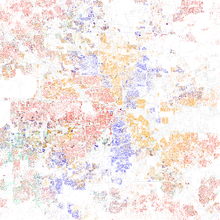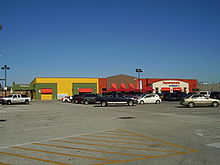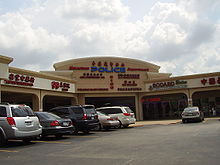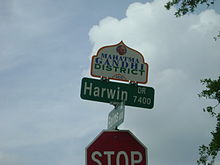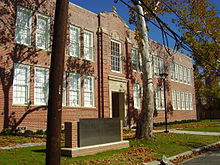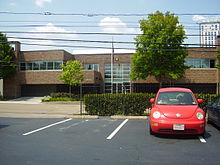- Demographics of Houston
-
This article on the demographics of Houston contains information on population characteristics of Houston, Texas, including households, family status, age, gender, income, race and ethnicity.
Contents
Population and households
City of Houston
Past censuses[1]Year Population Rank 1850 2,396 ? 1860 4,845 ? 1870 9,332 ? 1880 16,513 ? 1890 27,557 ? 1900 44,633 85 1910 78,800 68 1920 138,276 45 1930 292,352 26 1940 384,514 21 1950 596,163 14 1960 938,219 7 1970 1,232,802 6 1980 1,595,138 5 1990 1,630,553 4 2000 1,953,631 4 2010 2,099,451 4 As of the census[2] of 2000, there were 1,953,631 people, 717,945 households, and 457,330 families residing in the city. The population density was 3,371.7 people per square mile (1,301.8/km²). There were 782,009 housing units at an average density of 1,349.6 per square mile (521.1/km²). If the city of Houston were a U.S. state, it would rank 36th in population—its 2.01 million residents in 2004 would place it behind Nevada and ahead of New Mexico.[3][4] In 2005, the Greater Houston area had a population over 5.7 million.[5]
There were 717,945 households out of which 33.1% had children under the age of 18 living with them, 43.2% were married couples living together, 15.3% had a female householder with no husband present, and 36.3% were non-families. Twenty-nine percent of all households were made up of individuals and 6.2% had someone living alone who was 65 years of age or older. The average household size was 2.67 and the average family size was 3.39. The median house price was $115,961 in 2009.[6]
In the city, the population was spread out with 27.5% under the age of 18, 11.2% from 18 to 24, 33.8% from 25 to 44, 19.1% from 45 to 64, and 8.4% who were 65 years of age or older. The median age was 31 years. For every 100 females there were 99.7 males. For every 100 females age 18 and over, there were 97.8 males.
The median income for a household in the city was $36,616, and the median income for a family was $40,443. Males had a median income of $32,084 versus $27,371 for females. The per capita income for the city was $20,101. Nineteen percent of the population and 16% of families were below the poverty line. Out of the total population, 26.1% of those under the age of 18 and 14.3% of those 65 and older were living below the poverty line.
As of 2002, 38,000 people living in Houston also live in Fort Bend County; this makes Houston the third-largest city within Fort Bend County, after Missouri City and Sugar Land.[7]
Race and ethnic origins
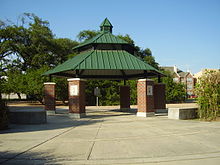 Vietnamese culture memorial at Baldwin Park in Midtown
Vietnamese culture memorial at Baldwin Park in Midtown
Houston is a diverse and international city, in part because of its many academic institutions and strong biomedical, energy, manufacturing and aerospace industries. According to the U.S. Census 2000, the racial makeup of the city was 49.3% White (including Hispanic or Latino), 25.3% Black or African American, 0.4% Native American, 5.3% Asian, 0.1&% Pacific Islander, 16.5% from other races, and 3.2% from two or more races. 37% of the population was Hispanic or Latino of any race.
The Daily Mail stated, in regards to the 2000 census data, that the racial and ethnic diversity in Houston and Greater Houston increases further from the center of the city.[8]
Hispanics
The Supermercado de Walmart store in the Spring Branch is designed to accommodate Hispanic customers
The Hispanic population in Houston is increasing as more immigrants from Latin American countries look for work in the area. As of 2006 the city has the third-largest Hispanic population in the United States. As of the same year Karl Eschbach, a University of Texas Medical Branch demographer, said that the best possible estimate for the number of illegal aliens in the Houston area was about 400,000.[9] This influx of immigrants is partially responsible for Houston having a population younger than the national average.[citation needed] As of 2011, the city is 44% Hispanic. As of 2011, of the city's U.S. citizens that are Hispanic, half are at voting age or older. Many Hispanics in Houston are not U.S. citizens, especially Hispanics living in Gulfton and Spring Branch. As a result, Hispanics have proportionally less representation in the municipal government than other ethnic groups. As of April 2011 two of the Houston City Council members are Hispanic, making up 18% of the council.[10]
As of 2001, Hispanics were almost 38% of Houston's population and 8% of the city's voting electorate. As of the same year, most Hispanics and Latinos elected to public office in Houston are Mexican Americans who are members of the Democratic Party. Most Hispanics and Latinos in public office are politically liberal. Lori Rodriguez of the Houston Chronicle said in 2001 that "the top tier of Latino politicos mainly walk in lock step."[11] According to Richard Murray, a political scientist of the Center for Public Policy of Rice University, the Hispanic middle class of 2001 is larger than in previous years, and that Hispanic voters are present in every Houston voting precinct, including River Oaks and Tanglewood.[11]
In 2001 Orlando Sanchez made a bid to become Mayor of Houston. Lori Rodriguez of the Houston Chronicle said that this was the first well-funded and focused campaign for Houston mayor from a Hispanic person. Sanchez, a Cuban American, was a member of the Republican Party and politically conservative.[11]
Around 2002 some Hispanics in Houston were converts to Islam. They said that many people mistake them to be of Pakistani or Middle Eastern origin because they are Muslim.[12]
In a period before 2005 many Hispanic and Latino Americans had moved into traditional African American neighborhoods. Between 1990 and 2000 the numbers of Hispanic and Latino Americans in Kashmere Gardens, South Park, Sunnyside, and the Third Ward increased.[13] Since the mid-1990s changes in immigration from Cuba to the United States occurred due to the wet feet, dry feet policy and other policy changes; many Cubans immigrated through Mexico and people who did not have relatives in Miami settled in Houston; this caused an expansion of Houston's Cuban American community.[14] After Hurricane Katrina hit New Orleans in 2005, many ethnic Hondurans moved to Houston.[15]
In 2007 most of the Hispanic and Latino political power was Mexican American, of the Democratic Party, and concentrated in eastern Houston. Many of the most vocal Hispanic and Latino leaders who participated in immigration rallies were of Central American origin and originated from Southwest Houston.[16]
By 2011 the new city council District J formed in order to allow Hispanics in Houston to more easily elect representatives that cater to them.[17]
Mexican-Americans
Main article: History of the Mexican-Americans in HoustonWhen Houston was first settled, it had relatively few Mexican Americans.[18] Mexican migration into Houston increased with the expansion of the railroad system and the installation of Porfirio Díaz as the President of Mexico.[19] In the early 20th century the population further increased due to the 1910 Mexican Revolution, the use of enganchadores (labor agents), unemployment of Mexican-Americans in rural areas, a labor shortage during World War I. and the lack of immigration restrictions during the 1920s.[20]
In the book Ethnicity in the Sunbelt: A History of Mexican Americans in Houston, author Arnoldo De León described the relationship between Houston Mexican-Americans and newly arrived immigrants from Mexico. De León said that the traditional residents disliked how they believed that the new immigrants were giving the Mexican-American community in Houston a bad reputation but added that that, at the same time, the new immigrants kept the entire community in touch with the Mexican community.[21]
East Asian Americans
Ranchester Police Storefront in Chinatown - The Chinese name is the Chinatown Police Station (中國城警察局 Zhōngguóchéng Jǐngchájú)
Houston also has large populations of immigrants from Asia. In addition, the city has the largest Vietnamese American population in Texas and third-largest in the United States.[22][23]
In 1910 30 Asians lived in Houston. 20 were Japanese and 10 were Chinese.[24]
By 2007 many Vietnamese Americans in Southern California were moving to Texas to take advantage of lower costs of living.[25] In 2007 Houston had 16,000 Asian American businesses. A 2006 U.S. Census Bureau report stated that the annual revenues of those businesses totaled to $5.5 billion.[26]
As of 2004 Houston had the fifth largest Indonesian population in the United States; this helps sustain the Consulate-General of Indonesia, Houston.[27]
African immigrants
A significant number of African immigrants have made the Houston area home.[28] As of 2003 Houston does not have as many African immigrants as Hispanic and Asian immigrants. The African immigrants in Houston have higher education levels than other immigrant groups. According to Stephen Klineberg, a sociology professor at Rice University, as of 2003, almost 35% of African immigrants have university degrees, and 28% of African immigrants have postgraduate degrees. In the Houston area, 28% of US-born Whites have university degrees, and 16% have postgraduate degrees.[29]
Charles W. Corey of the U.S. Department of State said that it has been estimated that Greater Houston has the largest Nigerian expatriate population in the United States. [28] As of 2003 Houston has 23,000 Nigerian Americans. Many Nigerian Americans move to Houston due to the warmer climate and the ease of establishing businesses.[29] Until Continental Airlines began nonstop flights to Lagos from George Bush Intercontinental Airport in November 2011, many Nigerians had to fly through Europe to travel between Texas and Nigeria.[30] Jenalia Moreno of the Houston Chronicle said that the Nigerian community and the energy companies in Houston have attempted to get a flight to Nigeria for a long time.[31]
South Asian Americans
Harris County had almost 36,000 Indian Americans as of the 2000 Census. The population had a $53,000 median yearly household income, $11,000 more than the county average. Almost 65% of the Indian Americans in Harris County had university and college degrees, compared to 18% of all of the Harris County population. Indian Americans in Fort Bend County, as of the same census, numbered at almost 13,000 and had a median annual income of $84,000. 62% of Indian Americans in Fort Bend County had university and college degrees, compared to 25% of all residents of Fort Bend County. An estimate from the 2009 American Community Survey stated that Harris County had 46,125 Indian Americans and that Fort Bend County had 25,104 Indian Americans. Katharine Shilcutt of the Houston Press said that the high education and income levels of Indian Americans caused businesses in the Mahatma Gandhi District, an Indian American ethnic enclave in Houston, to thrive.[32]
Half a dozen Indian American and Pakistani American newspapers are offered in stores and restaurants. The publications include India Herald and the Voice of Asia. The city has Masala Radio, a South Asian radio station. Indian singers often make tour stops in Houston. The Bollywood 6 movie theater on Texas State Highway 6 plays Indian films. The Houston area has Indian dance schools, including the Abhinaya School of Performing Arts and the Shri Natraj School of Dance.[33]
In 1971 the Bangladeshi American community in Greater Houston consisted of about 10 university students; 1971 was the year when Bangladesh seceded from Pakistan. As of 2011 the Bangladeshi American population of Greater Houston includes over 10,000 people. The Bangladesh Association bought 4 acres (1.6 ha) of land in southwestern unincorporated Harris County in 2001. By 2011 the association announced plans to develop the $2.5 million facility Bangladeshi American Center, which will include auditoriums, classrooms, a playground, and an outdoor sports complex.[34]
White Americans
White Americans of northern and western European origin, particularly those of German and British origins, founded the City of Houston. Roberto R. Treviño, author of The Church in the Barrio: Mexican American Ethno-Catholicism in Houston, said that German Americans "historically played a central role in Houston, far outnumbering other whites such as the British, Irish, Canadians, French, Czechs, Poles, and Scandinavian groups who historically have comprised a smaller part of the city's ethnic mosaic."[24] In 1910 members of White American groups who founded Houston numerically outnumbered other ethnic groups who had arrived in Houston.[24]
By the 1970s, white flight occurred in Houston. The city government used annexation as a strategy to mitigate White flight by forcefully annexing areas where White Americans moved to.[35] Between the 1970-1971 and the 1971-1972 school years, enrollment at the Houston Independent School District decreased by 16,000. Of that number, 700 were African Americans.[36]
African-Americans
Historically Houston has had a significant African American population. From the 1870s to the 1890s, black people were almost 40% of Houston's population. Between 1910 and 1970 the black population ranged from 21% to 32.7%.[24]
In 1970, 90% of the black people in Houston lived in mostly African-American neighborhoods. By 1980 this decreased to 82%.[37]
Historically the City of Houston placed most of its landfill facilities in African-American neighborhoods. All of the landfills were established after the neighborhoods they were located in had been established as black communities. Private companies also located landfills in black neighborhoods. Between the early 1920s and the late 1970s the five municipal sanitary landfills were in black neighborhoods. During the same period, six of the eight municipal solid waste incinerators resided in mostly black neighborhoods. From 1970 to 1978 three of the four private landfills established during that period were located in Houston black neighborhoods.[37] Around that era African-Americans made up around 25% of the city's population. Houston City Council, which decided where the landfills would be located, was entirely composed of white people until 1972.[38] The political efforts and advocacy behind a 1979 federal lawsuit regarding one proposed landfill lead to political changes that ended the deliberate placement of landfills in black neighborhoods.[38][39]
As of 1987 most African-Americans in Houston continued to live in mostly black neighborhoods, even though they gained the legal right to move to a neighborhood of any race. A University of Chicago researcher said that this is because many African Americans choose to live in neighborhoods where they were raised.[40]
From the 1980 U.S. Census to the 1990 Census, many African-Americans left traditional African-American neighborhoods such as the MacGregor area, Settegast, Sunnyside, and the Third Ward and entered parts of Southwest Houston, such as Alief, Fondren Southwest, Sharpstown, and Westwood.[41]
As of 1997, African-Americans typically constituted less than 25% of the electorate of the City of Houston. For the election of Mayor of Houston Lee P. Brown, blacks may have made up over 33% of the turnout. Brown won 90% or more in African American neighborhoods.[42]
By of 2005 the outflow from traditional black neighborhoods, such as the Third Ward, Sunnyside, Kashmere Gardens, and the Fifth Ward continued, with blacks moving to Alief, other parts of Southwest Houston, Missouri City, and northwestern suburbs. Around 2005 blacks began to move to an area around Farm to Market Road 1960, in an unincorporated area in Harris County. In many traditional black neighborhoods, Hispanics and Latinos moved in their place.[13]
An additional 150,000 to 200,000 mostly black evacuees arrived in 2005 from New Orleans after Hurricane Katrina, with many of them deciding to stay.[citation needed]
European residents and immigrants
In the late 19th and early 20th century Houston received Eastern and Southern European immigrants; as in other southern cities, Houston's European immigrants were "overflow" from cities in the eastern seabord and the Midwestern United States which received larger numbers of Eastern and Southern Europeans. In 1910 Houston had groups of Austro-Hungarians, Greeks, Italians, Russians, and Europeans from other groups. Those groups were smaller than Houston's group of Mexican-Americans. By 1930 Houston had 8,339 first and second generation Eastern and Southern European people in Houston. This was almost half of the size of Houston's Mexican American population.[24]
Lasse Sigurd Seim, the consul general of the Norwegian Consulate General, Houston, described the estimated 5,000–6,000 Norwegians in the Houston area around 2008 as the largest concentration of Norwegians outside of Scandinavia. Jenalia Moreno of the Houston Chronicle said during that year that the influx of Norwegians into Greater Houston was "relatively new."[43] Seim said that in the late 1800s, of all of the ports in the United States, with the exception of Ellis Island in New York City, more Norwegians arrived at the port of Galveston than any other port. Many of the Norwegians who were processed through Galveston migrated to Minnesota and other areas in the Midwestern United States.[43]
In a 2004 Houston Chronicle article Nikolai V. Sofinskiy, the first consul general of the Consulate-General of Russia in Houston, stated that the Houston area had around 40,000 Russian speakers.[44]
Annette Baird of the Houston Chronicle said that, as of December 2000, the number of British citizens in Greater Houston was estimated to be over 40,000. Grainne O'Reilly-Askew, the first headmistress of the British School of Houston, said that before the school was established, British companies encountered difficulty in convincing their executives to relocate to Greater Houston, since the area previously did not have a school using the British educational system.[45] John Major, the former Prime Minister of the United Kingdom, attended the school's official opening.[46]
Refugee populations
Since the 1970s, when Houston began absorbing refugees after the Fall of Saigon, Houston became a magnet for refugee resettlement. About 1,600 refugees arrive at George Bush Intercontinental Airport per year. Refugees from Afghanistan, Bhutan, El Salvador, Cuba, Iraq, Myanmar, and Somalia have settled in Houston; Burundians from Rwanda have also settled in Houston. Over the three years leading to 2009, Houston took about 2,200 Burmese.[47]
Health
In 2010 the University of Texas Health Science Center at Houston released a Health of Houston Survey. Based on the survey results, 20% of area residents consider themselves to be in poor or fair health. Half of the Houston area residents do not have dental insurance. The area's percentage of individuals who report having psychiatric distress is twice the U.S. national average. Of the racial groups, after excluding illegal immigrants, Hispanics have the lowest rates of health insurance.[48]
References
- ^ Population of the 100 Largest Cities and Other Urban Places in the United States: 1790 to 1990. Campbell Gibson, Population Division, U.S. Census Bureau. Published June 1998. Last accessed January 11, 2007.
- ^ "American FactFinder". United States Census Bureau. http://factfinder.census.gov. Retrieved 2008-01-31.
- ^ Demographics. Greater Houston Partnership
- ^ Annual Estimates of the Population for Incorporated Places over 100,000, Ranked by July 1, 2005 Population: April 1, 2000 to July 1, 2005 (SUB-EST2005-01). United States Census Bureau
- ^ Post-Census Population Change: Houston is growing faster than the state and the nation. Greater Houston Partnership
- ^ "Houston Housing Trends and Values". HouseAlmanac.com. http://houston.housealmanac.com/. Retrieved 2009-12-14.
- ^ De Mangin, Charles. "Neighborhood charts its course." Houston Chronicle. Thursday November 14, 2002. Retrieved on October 27, 2011.
- ^ Gardner, David. "Revealed: The maps that show the racial breakdown of America’s biggest cities." Daily Mail. September 26, 2010. Retrieved on November 12, 2011.
- ^ Hegstrom, Edward. Shadows cloaking immigrants prevent accurate count. Houston Chronicle (February 21, 2006).
- ^ Casey, Rick. "City Hall Latino win may end up as a loss instead." Houston Chronicle. April 28, 2011. Retrieved on June 6, 2011.
- ^ a b c Rodriguez, Lori. "Sanchez's mayoral bid targets disparate voters." Houston Chronicle. Sunday October 7, 2001. A1. Retrieved on October 27, 2011.
- ^ Dooley, Tara. "Muslims gain Hispanic converts." Houston Chronicle at The Victoria Advocate. Saturday September 28, 2002. 2D and 3D. Retrieved from Google Books (45-46 of 51) on November 9, 2011.
- ^ a b Rodriguez, Lori. "SHIFTING DEMOGRAPHICS / Latinos bringing change to black neighborhoods / Newcomers are finding acceptance comes gradually." Houston Chronicle. Monday May 2, 2005. A1. Retrieved on February 4, 2009.
- ^ Cobb, Russell and Paul Knight. "Immigration: Cubans Enter U.S. at Texas-Mexico Border." Houston Press. January 8, 2008. 1. Retrieved on December 11, 2009.
- ^ Schilcutt, Katharine. "Honduras in Houston." Houston Press. Thursday August 19, 2010. Retrieved on August 23, 2010.
- ^ Garza, Cynthia Leonor. "Latinos' political power hasn't matched growth." Houston Chronicle. Sunday August 19, 2007. 2. Retrieved on November 22, 2011.
- ^ Shauk, Zain. "Hispanic-opportunity district draws three candidates." Houston Chronicle. Friday October 14, 2011. Retrieved on November 4, 2011. (Refer to image, Archive)
- ^ Treviño, Robert R. The Church in the Barrio: Mexican American Ethno-Catholicism in Houston. UNC Press Books, February 27, 2006. 15. Retrieved from Google Books on November 22, 2011. ISBN 0807856673, 9780807856673.
- ^ Treviño, Robert R. The Church in the Barrio: Mexican American Ethno-Catholicism in Houston. UNC Press Books, February 27, 2006. 26. Retrieved from Google Books on November 22, 2011. ISBN 0807856673, 9780807856673.
- ^ Treviño, Robert R. The Church in the Barrio: Mexican American Ethno-Catholicism in Houston. UNC Press Books, February 27, 2006. 28. Retrieved from Google Books on November 22, 2011. ISBN 0807856673, 9780807856673.
- ^ Walsh, Robb. "The Authenticity Myth." Houston Press. October 26, 2000. Retrieved on November 16, 2009.
- ^ Money Smart Press Release. Federal Deposit Insurance Corporation
- ^ Power Speaks Spanish in Texas. Puerto Rico Herald
- ^ a b c d e Treviño, Robert R. The Church in the Barrio: Mexican American Ethno-Catholicism in Houston. UNC Press Books, February 27, 2006. 29. Retrieved from Google Books on November 22, 2011. ISBN 0807856673, 9780807856673.
- ^ Tran, My-Thuan. "Flocking from SoCal to Houston." Los Angeles Times. December 21, 2007. 1. Retrieved on May 19, 2010.
- ^ Moreno, Jenalia. "Houston's 'Chinatown' near Beltway 8 sparks banking boom." Houston Chronicle. Sunday February 18, 2007. Retrieved on October 16, 2011.
- ^ Aqui, Reggie (2004-12-27). "Houston's connection to Indonesian earthquake victims". KHOU-TV. http://www.khou.com/news/local/stories/khou041227_cd_reggieearth.4f350cbc.html.
- ^ a b Corey, Charles W. "Houston Looking to Expand a "Natural" Relationship with Africa." U.S. State Department. November 21, 2003. Retrieved on December 11, 2009.
- ^ a b Romero, Simon. "Energy of Africa Draws the Eyes of Houston." The New York Times. September 23, 2003. [1]. Retrieved on October 24, 2011.
- ^ Lawal, Lateef. "United Continental Launches Inaugural Flight Between Houston-Lagos." Eagle News Nigeriana at OfficialWire. November 17, 2011. Retrieved on November 17, 2011.
- ^ Moreno, Jenalia. "Houston gets first scheduled nonstop flight to Africa." Houston Chronicle. Tuesday November 15, 2011. Retrieved on November 17, 2011.
- ^ Shilcut, Katharine. "Little India." Houston Press. Wedmesday May 25, 2011. 1. Retrieved on May 26, 2011.
- ^ Shilcut, Katharine. "Little India." Houston Press. Wedmesday May 25, 2011. 4. Retrieved on May 26, 2011.
- ^ Christian, Carol. "Bangladeshis plan SW Harris center More than 10,000 from ex-East Pakistan live in Houston." Houston Chronicle. June 2, 2011. Retrieved on June 3, 2011. "As envisioned, the $2.5 million facility at 13145 Renn Road in southwest Harris County will have an auditorium and classrooms as well as an outdoor sports complex and playground."
- ^ "City bucks the trend Others dying, Houston thrives." Associated Press at the Southeast Missourian. January 18, 1975. Page 4. Retrieved from Google Books (8 of 17) on November 3, 2011.
- ^ "White flight accompanies integration." Associated Press at the The Telegraph-Herald. Monday January 17, 1972. 6 Retrieved from Google Books (6 of 38) on October 3, 2011.
- ^ a b Finkel, Adam N. Worst Things First?: The Debate Over Risk-Based National Environmental Priorities. Resources for the Future, 1995. 249. Retrieved from Google Books on October 6, 2011. ISBN 0915707764, 9780915707768
- ^ a b Gaventa, John, Barbara E. Smith, and Alex W. Willingham. Communities in Economic Crisis: Appalachia and the South. Temple University Press, 1990. 196. Retrieved from Google Books on October 6, 2011. ISBN 0877226504, 9780877226505.
- ^ Gaventa, John, Barbara E. Smith, and Alex W. Willingham. Communities in Economic Crisis: Appalachia and the South. Temple University Press, 1990. 197. Retrieved from Google Books on October 6, 2011. ISBN 0877226504, 9780877226505.
- ^ Greene, Andrea D. "Residents of black areas cite reasons for not moving out." Houston Chronicle. Wednesday December 30, 1987. Section 1, Page 16. Retrieved on January 13, 2011.
- ^ Rodriguez, Lori. "Census tracks rapid growth of suburbia." Houston Chronicle. Sunday March 10, 1991. Section A, Page 1. Retrieved on October 23, 2011.
- ^ Fleck, Tim. "The Insider." Houston Press. Thursday November 13, 1997. 1. Retrieved on November 5, 2011.
- ^ a b Moreno, Jenalia. "For Norway, Houston is Oslo on the bayou / Many from Scandinavian nation, which has a major oil industry, are finding opportunities in Texas." Houston Chronicle. Sunday August 17, 2008. Business 1. Retrieved on February 11, 2009.
- ^ Lezon, Dale. "Energy, space draw Russian consulate here." Houston Chronicle. May 26, 2004. A21 MetFront. Retrieved on February 11, 2009.
- ^ Baird, Annette. "British school to expand to accommodate demand." Houston Chronicle. Wednesday December 20, 2000. ThisWeek 2. Retrieved on December 9, 2010.
- ^ Staff. "A major opening." Houston Chronicle. Thursday September 21, 2000. A36. Retrieved on December 9, 2010.
- ^ Giglio, Mike. "The Burmese Come to Houston." Houston Press. September 1, 2009. 1. Retrieved on December 19, 2009.
- ^ Ackerman, Todd. "Survey finds Houstonian health worse than national average." Houston Chronicle. Monday November 7, 2011. Retrieved on November 7, 2011. Map. (Image archive)
External links
- Houston demographics - Greater Houston Partnership - Houston.org
- Health of Houston Survey 2010 - University of Texas Health Science Center at Houston
- City of Houston page on demographic information
- Houston demographics at University of Wisconsin–Eau Claire
- Fountain, Ken. "Ethnicity, economy highlight Houston area survey results." The Examiner. Saturday April 23, 2011.
 City of HoustonNickname: Space City
City of HoustonNickname: Space CityTopics History | Geography | Climate | Politics | Mayors | Economy | Demographics | Culture | Architecture | Transportation | Education | Nicknames | Sister cities
Attractions Theater District | Bayou Place | Museum District | Houston Zoo | Hermann Park | Space Center Houston | the Galleria | Waterwall Park | Memorial Park | Discovery Green | Lee and Joe Jamail Skatepark | University of Houston
Business Districts Downtown | Uptown | Texas Medical Center | Greenway Plaza | Energy Corridor | Westchase | Memorial City | Greenspoint
See also: List of companies in HoustonCommunities Acres Homes | Addicks | Alief | Almeda | Bordersville | Boulevard Oaks | Braeburn | Braeswood Place | Brays Oaks | Blue Ridge | Chinatown | Clear Lake City | Denver Harbor | East Downtown | East End | East Houston | Genoa | Glenbrook Valley | Greater Sharpstown | Gulfton | Harrisburg | Hiram Clarke | Houston Heights | Independence Heights | Inwood Forest | Kingwood | Magnolia Park | Maplewood | Meyerland | Midtown | Montrose District | Museum District | Neartown | Near Northwest | North Shore | Northside | Oak Forest | River Oaks | Riverside Terrace | South Park | Spring Branch | Sunnyside | Upper Kirby
Historic wards: First Ward | Second Ward | Third Ward | Fourth Ward | Fifth Ward | Sixth Ward
See also: The six wards of HoustonNeighborhoods Afton Oaks | Brentwood | Briargrove Park | City Park | Clinton Park | Cloverland | Corinthian Pointe | Crestwood | Eastwood | Garden Oaks | Highland Village | Houston Gardens | Idylwood | Kashmere Gardens | Larchmont | Magnolia Grove | Montrose | Morningside Place | Near North Side | Nottingham Forest | Old Braeswood | Pecan Park | Port Houston | Rice Military | Robindell | Royal Oaks Country Club | Settegast | Sharpstown | Shenandoah | University Oaks | Walnut Bend | Westbury | West End | Westmoreland | Willow Meadows | Willowbend | Woodland Heights
See: List of Houston neighborhoodsEducation Public universities: University of Houston | University of Houston–Clear Lake | University of Houston–Downtown | Texas Southern University
Private universities: Rice University | Houston Baptist University | University of St. Thomas
Community colleges: Houston Community College | Lone Star College | San Jacinto College
See: List of colleges and universities in HoustonCategories:
Wikimedia Foundation. 2010.

